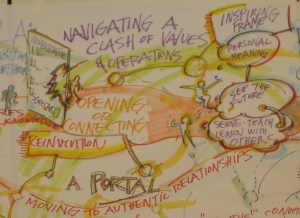Fourteen social sector leaders assembled in Colonial Williamsburg for Gary Hubbell Consulting’s Conversation 2010, held April 28 through May 1. The story of our conversation is indicative, perhaps, of the process many individuals, organizations and society at large are experiencing during this time of mixed signals and uncertainty.
Loose From Our Moorings: We found ourselves seemingly grappling for our moorings during a sustained turbulent time unlike any other we had experienced. During this time, it is becoming increasingly evident that things are different, yet it remains unclear what is emerging. Seemingly, we are unsure what we value in this time and we search for clarity of understanding of what is most important during “this moment” in our personal, organizational, and globally-connected lives. For some, this moment is characterized by scarcity, increasing polarization, and rootlessness. We see the symptoms of a clash of cognition, a clash of values, and a clash of operations.

Unwilling (or unready) to let go of what has worked well before, we find ourselves working harder to control our environment. Leadership conversations narrow around “sticking to our knitting” and focusing more intently upon the quantifiable scorecard to gauge our effectiveness. Frustration builds as we realize that this posture is increasing ineffective and out of balance. Constantly in search of the big idea, we speculate about the locus of control or influence of that idea, wrestling sometimes with the question of “Who leads” during times like this. Ultimately, we come to understand and appreciate that leading requires a recognition and willingness that each of us must play multiple roles at different times—visionary, leader, facilitator, follower, teacher. Leading requires equal parts personal insight and personal courage to recognize the need to be in a different conversation than those before. We are called upon to be aligned and authentic with our organizational leaders (CEOs, boards, executive teams) and with our funders (donors/partners), born of our recognition as practitioners that our approaches to philanthropy and, oftentimes, the application of those donated resources are not working as well as we’d hoped and is unlikely to be adequate to the challenges of the future.

This is the first of several summary posts from Conversation 2010.